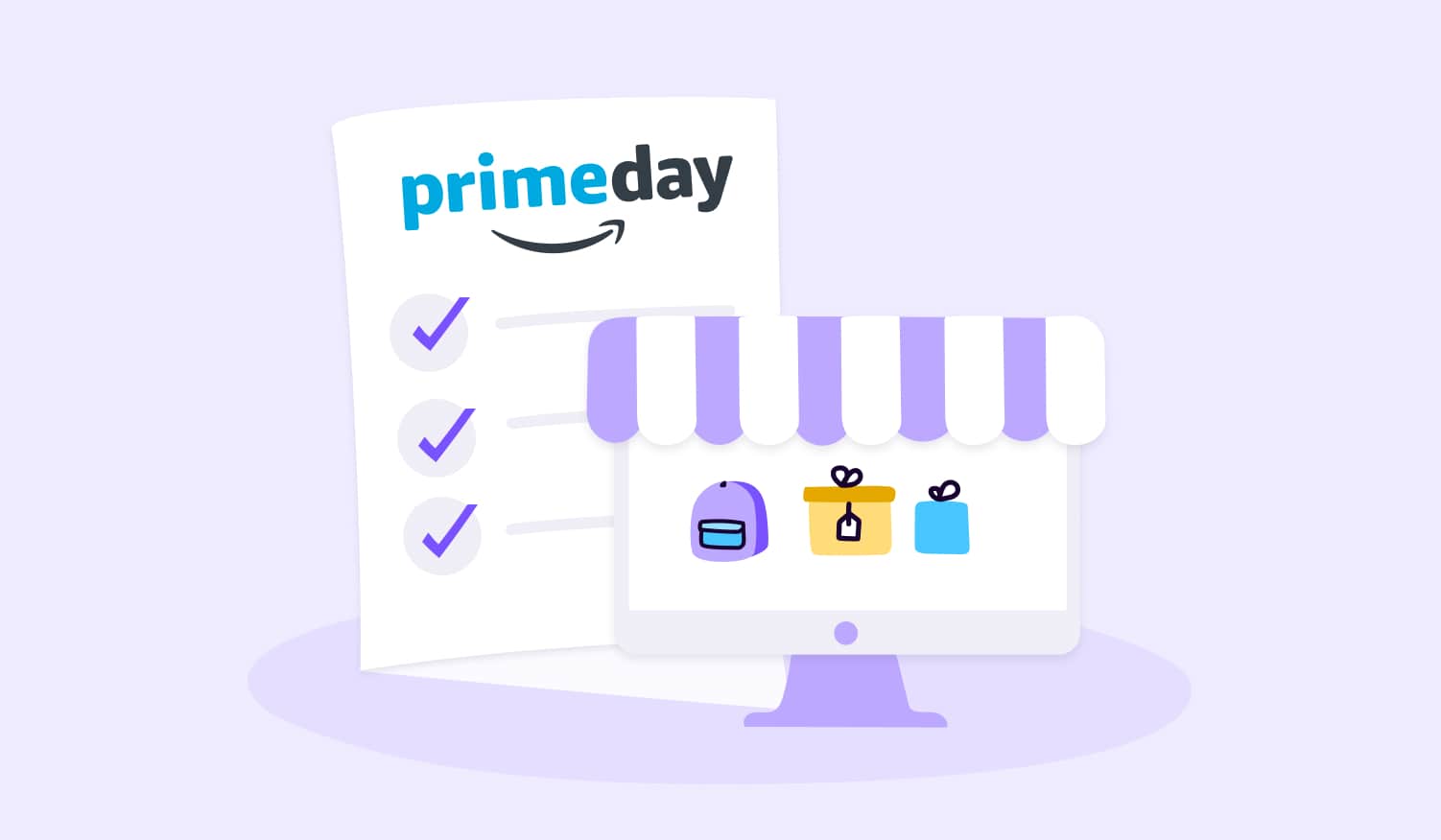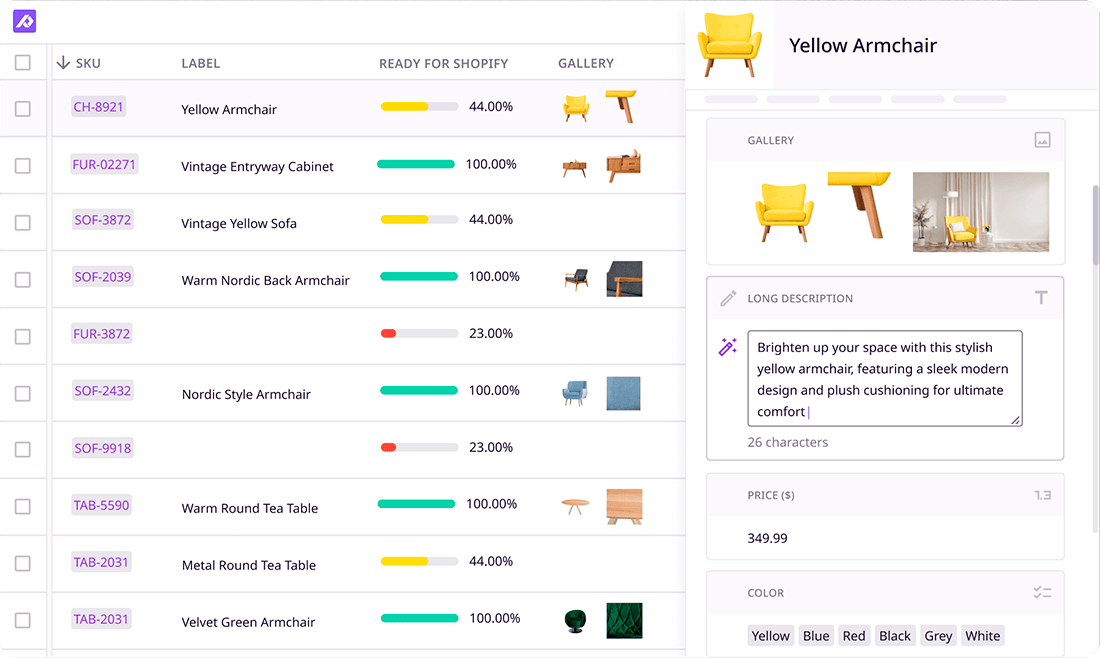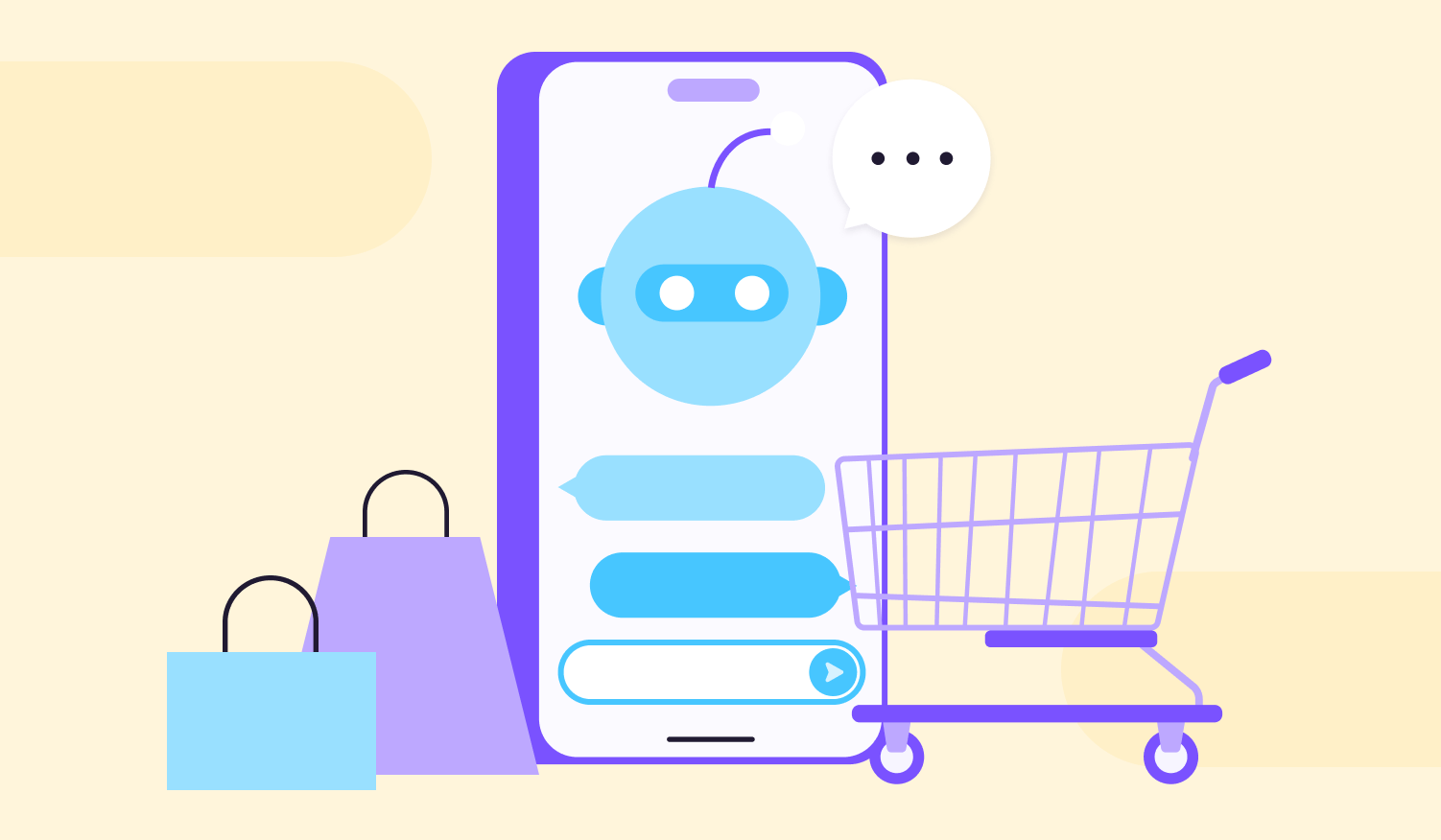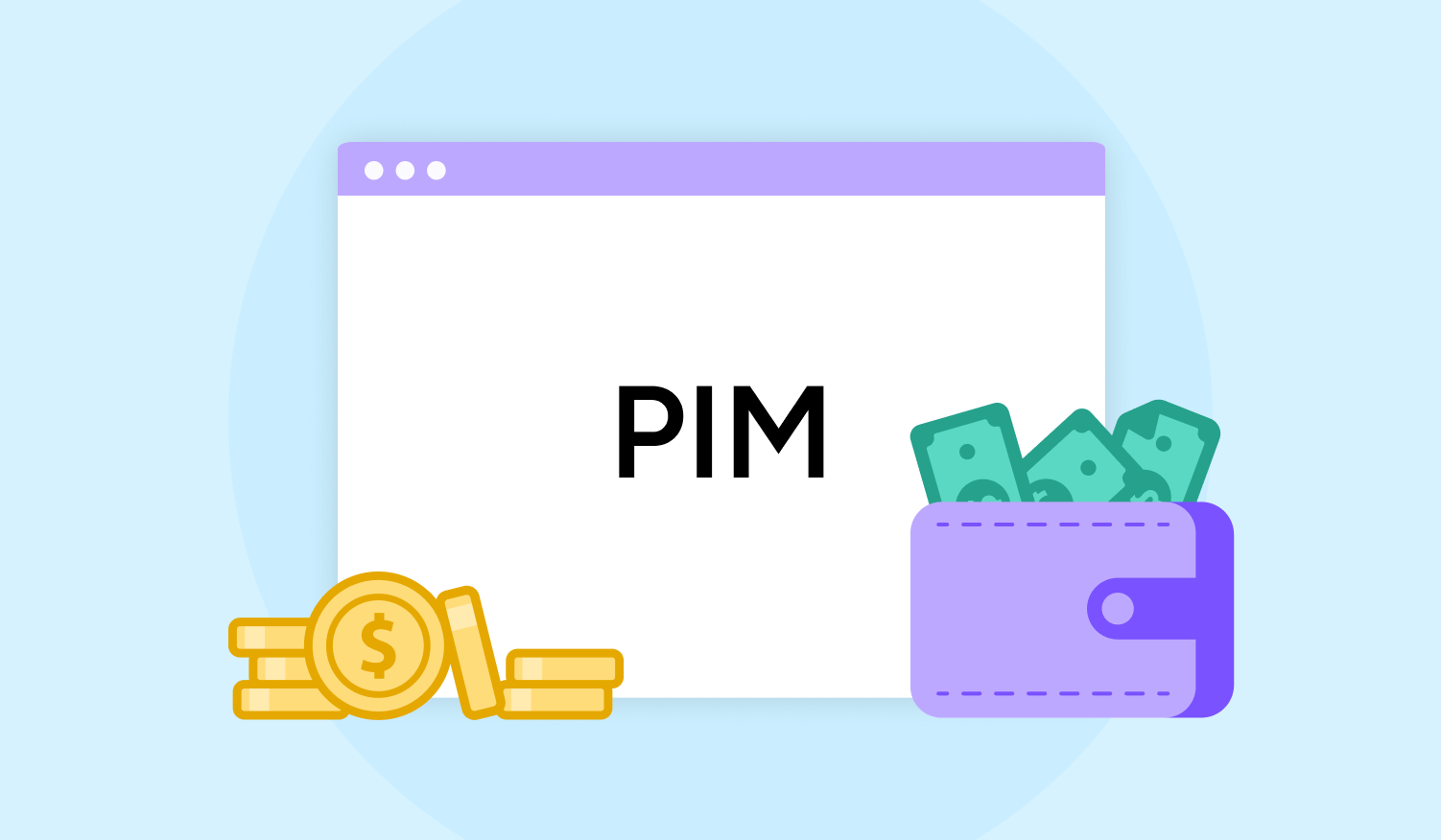
Keep the good stuff coming
Subscribe to our blog newsletter and get monthly content that helps you manage product data smarter.
No spam. Just real value.
Amazon Prime Day is fast approaching. Which means Prime Members all over the world are busy putting together wishlists, planning major purchases, and limbering up ready to chase down the best deals possible.
Since you’re here, we’ll assume that you want to get in on the fun and are hoping to maximize your sales over what will be Amazon’s longest ever Prime Day (stretching four days instead of the usual two).
After all, since the year it was launched, Prime “Day” has proven to be a major win for businesses selling on Amazon. In 2024 alone, it generated 14.2 billion U.S. dollars worth of sales and involved over 180 million shoppers. And it’s not just big businesses cashing in. In 2024, independent sellers (most of which are small and medium-sized businesses) sold more than 200 million items.

So, how exactly do you make sure that your store is set up to bring in the most sales possible over the four days? Let’s dive into the tips and tricks that will allow you to take advantage of Amazon Prime Day. But first, a quick recap: what actually is Amazon Prime Day?
What is Amazon Prime Day?
Amazon Prime Day is a major sales event exclusively for Amazon Prime members. Typically held in the summer (this year it will be in July, though the final date hasn’t been announced yet), it offers deals and discounts across every product type sold on Amazon.
Traditionally, Prime Day has run for two days (48 hours), but this year you’ll have even more time to make your sales, with Amazon Prime members getting access to exclusive deals for four days (96 hours).
During Prime Day, sellers compete fiercely, slashing prices and stacking offers to grab attention. While many purchases are impulsive, there are opportunities for all Amazon sellers here, with savvy shoppers often holding out on buying big-ticket items (like TVs or washing machines) in order to get the best deal possible during Prime Day.
Billed as their biggest deal event of the year, Amazon staff will have been prepping months in advance for the increase in sales, boosting staff in fulfillment centers and delivery stations, and promoting the event everywhere possible. And they’re not alone; Amazon sellers will have been prepping, too.
Can anyone sell on Prime Day?
Yes and no. Anyone can sell on Amazon during Prime Day (and benefit from the increased traffic it brings), but not everyone can participate in official Prime Day deals.
To qualify for Amazon’s featured Prime Day promotions, you must:
- Be enrolled in the FBA (Fulfillment by Amazon) program
- Meet specific performance metrics (like high seller ratings, good delivery times, etc.)
- Submit your deals in advance—usually by late May or early June
Even if you missed the submission window or aren’t FBA-eligible, you should still be preparing your store and running your own promotions during Prime Day (think lightning deals, coupons, or strategic pricing). Sellers who do still see a boost in visibility and sales thanks to the buyers (Prime members and non-Prime members alike) flocking to Amazon during the sale.
Get your Amazon store ready for Prime Day sales using these steps
1. Plan your inventory
Start by deciding which products you’ll put on sale. That might mean everything, but often, a more targeted strategy gets better results.
Dig into your sales data from previous shopping events like Black Friday, Boxing Day, or past Prime Days. What’s the trend? Are customers snapping up low-cost impulse buys? Or are they waiting for deals on higher-ticket items? These patterns are your best clue for what to discount this time around.
You can also look at broader Prime Day trends to guide your choices. During last year’s shopping showdown, the product categories that saw the biggest increase in sales were:
- Health & Beauty (23% increase)
- Active Footwear (10% increase)
- General Handbags (12% increase)
If you sell products in any of these categories, they’re strong contenders for Prime Day promotions.
Discounts matter too. Some product categories saw deeper average discounts than others. The products with the biggest discounts?
- General Apparel (average discount of 28%)
- Beauty & Makeup (average discount of 26%)
- Home & Furniture (average discount of 24%)
If you're in these spaces, it’s worth doing a little recon to see how your pricing stacks up. A competitive discount could make all the difference.
Once you’ve decided what to promote, double-check your stock levels. If anything’s running low, now’s the time to restock. Don’t forget to stock up on complementary products too—cross-selling and upselling are great ways to boost your average order value. A shopper lured in by a great deal might just grab a few extras while they’re at it.
2. Optimize your Amazon product listings
Once you’ve decided which products to promote, it’s time to make sure that they 1) show up in search and 2) give buyers the information they need to click “add to cart.” That’s where Product Listing Optimization (PLO) comes in.
Here’s how to optimize your product listings:
Start with strong keywords
Before you do anything else, figure out what your customers are searching for when they’re looking for your product. Use keyword tools, your Amazon Search Term report, or just the search bar itself to identify relevant phrases.
For example, if you're selling a cordless vacuum, customers might be searching for:
- “Cordless vacuum cleaner”
- “Lightweight hoover”
- “Vacuum for pet hair”
These keywords should guide your entire listing—especially the title and bullet points.
New to this? Check out our beginner-friendly keyword research guide.
Write listings that sell
Remember the keyword research we mentioned above? Now’s the time to make it count. We need those keywords to increase the chances of your products being found (and bought). Use them to write:
- A clear, keyword-rich title. A structure like “BrandName Cordless Vacuum Cleaner – Lightweight, Bagless, Pet Hair Friendly” will help you add as many keywords as possible and show buyers this is just what they’ve been looking for.
- Scannable bullet points that highlight key features and keywords (like suction power, battery life, portability, or included accessories) so it’s easy for buyers to find the information they need.
- A compelling product description that tells a story and answers common questions. Again, include your keywords here.
Add visuals that do the talking
Shoppers can’t touch your product, so your visuals have to do the selling. Add a combination of images if possible. Ideally, you should add:
- High-resolution images on a white background
- Lifestyle photos that show the product in use
- Infographics that highlight features
- Short, mobile-friendly videos (show setup, benefits, or comparison shots)
Remember: Most customers are browsing on mobile. Avoid blurry images, overloaded text, or anything that slows down page load. Stick to Amazon’s image and video requirements.
Keep everything up to date
If you’re using a Product Information Management (PIM) tool, now’s the time to lean on it. Any mistakes or missing information might mean a sale lost, so make sure your listings reflect:
- Your latest product descriptions and titles
- Accurate feature lists and up-to-date photos
- Prime Day promotional pricing
- Any new product attributes or variants that might tempt buyers
The goal? Give your customers all the information they need to buy confidently, reduce friction, and avoid post-sale headaches like returns or complaints.
Pro tip: If you’re not already using a Product Information Management (PIM) tool, now might be the time to think about it. A PIM keeps all your product information (like title, descriptions, and images) up-to-date and in one place, syncing it to sales channels like Amazon automatically, so you’re always ready for high-traffic events like Prime Day.
3. Price competitively
Prime Day shoppers are deal hunters—they’re looking for deep discounts, lightning-fast delivery, and no-nonsense value. If your pricing isn’t sharp, you’ll likely get overlooked.
Not sure if you're eligible to run official Prime Day deals? Amazon requires sellers to submit promotional pricing in advance of Prime Day. If you’re not sure when the deadline is, check Amazon Seller Central or reach out to Amazon to find out. If you missed the submission window, you can still run your own discounts to benefit from the increased traffic on Amazon. But bear in mind that they won’t be featured in Amazon’s official Prime Day promos.
What kind of deals can you run?
You’ve got a few options:
- Lightning Deals: Short-term, high-visibility promos that appear on Amazon’s Deals page. Great for high-velocity products with wide appeal.
- Coupons: These add an eye-catching green tag to your listing and allow you to offer a fixed or percentage discount. Easy to set up and low risk.
- Prime Exclusive Discounts: Limited-time deals only visible to Prime members. Perfect for standing out on Prime Day if you’re price-matching competitors.
- Bundles: Offer complementary products together at a lower price. Helps increase average order value and clear slower-moving stock.
4. Leverage social media and email marketing
Just because your discounts are exclusive to Amazon doesn’t mean the buzz has to stay there. Use your own channels—like social media and email—to build hype and drive traffic to your Amazon listings.
Start early. Let your audience know that if they’re Prime members (or considering a free trial in July), they’ll be able to snag exclusive deals on your products. People love a heads-up when there’s a bargain involved.
Social media is perfect for building excitement in real time. Tease your offers, share countdowns, post behind-the-scenes content—whatever gets people talking. Engage with your audience too. Reply to questions, like posts, and keep the conversation going.
Email marketing lets you take a more personal approach. Segment your list, send sneak peeks, and create a sense of urgency with clear CTAs that drive clicks straight to your Amazon store.
The goal? Build anticipation, get people ready to buy, and make sure your audience knows exactly where to find you when Prime Day hits.
5. Optimize your Prime Day advertising campaigns
The best part about Prime Day is that it’s an Amazon event, which means you can take advantage of Amazon’s advertising opportunities to boost your visibility and reach. Amazon offers multiple ad formats, each with its own strengths. Here’s a breakdown to help you decide what to use, how to use it, and where to put your money.
Sponsored Products
These are the bread and butter of Amazon ads. They appear in search results and on product pages and are great for targeting individual products you're promoting.
Best for: Driving traffic directly to specific deals.
Use when: You want high visibility for bestsellers, new launches, or discounted items.
Pro tip: Focus on high-converting keywords and increase your bids around Prime Day to stay competitive.

Sponsored Brands (aka Headline Search Ads)
These show up at the top of search results with your logo, a custom message, and multiple product listings.
Best for: Building brand awareness while showcasing a product range.
Use when: You want to highlight more than one product—great for Prime Day bundles or product categories.
Pro tip: Direct traffic to a custom Store page if possible for a cleaner, more branded experience.

Sponsored Display
These are audience-targeted ads that show up on and off Amazon. You can re-target shoppers who’ve viewed your products or hit them with interest-based ads.
Best for: Re-engaging warm leads or expanding your reach beyond Amazon.
Use when: You have a slightly higher budget and want to stay top of mind before and during Prime Day.
Pro tip: Combine these with Sponsored Products for both discovery and re-engagement.

How much should you spend?
Everyone will be upping their budget around Prime Day. If you want to stay competitive, you’ll need to, too.
Should you promote every item on sale? Not necessarily. If your budget is limited, focus your ad spend on products with high conversion rates and solid reviews or your bestselling products. If you spread your budget too thin, you'll end up with underpowered campaigns. Choose fewer, better-performing products and support them with strong keywords and compelling product content.
Here are a few tips to help you get the most out of your money:
- High-margin products (ones that generate a large profit compared to their cost) or high-velocity products (ones that sell quickly or in high volumes) are worth bidding higher on. These can carry your sales volume and justify a bigger slice of your budget.
- For low-margin or niche products, use more targeted, low-spend campaigns to avoid burning cash on low returns.
- New products? Test them with a modest budget—but only if your listings are solid and ready to convert.
Start with a clear total budget, then split it:
- 60% to Sponsored Products (core performers)
- 25% to Sponsored Brands (focus on product categories or bundle deals here)
- 15% to Sponsored Display (retargeting customers who have viewed your products, or brand awareness)
You’ll want to start raising your bids before Prime Day officially kicks off (48-72 hours before, ideally) to capture those early shoppers before the real competition begins. Make sure you monitor your performance daily so you can adjust your budget and bids as needed.
6. Monitor and analyze your Amazon Prime Day performance
This step comes once the party’s over… or at least slowed down. Just because Prime Day is officially done doesn’t mean the fun is. The so-called Prime Day “halo effect" (when all retailers see an increase in sales, not just Amazon) holds true on Amazon itself. Sales stay strong even after the event, because while news outlets are busy reporting on record-breaking sales, shopping stays top of mind, and traffic remains high.
Prime Day gives your brand a visibility boost. Don’t waste it.
- Follow up with post-Prime Day promotions to keep the momentum going whilst traffic is still high.
- Run retargeting ads to reach visitors who checked out your products but didn’t convert. Keep reduced discounts running to tempt them back.
- Invite customers to join your email list, loyalty program, or follow you on social while your brand is still fresh in their mind. They might not have bought this time, but that doesn’t mean they never will.
Dig into your data
Invest in your long-term success by using Amazon Seller Central (or third-party tools) to evaluate how your deals and ads performed. Prime Day comes around every year—and there are plenty of other events in between—so knowing what worked (and what didn’t) will help you hit harder next time. Look at:
- Which products converted best?
- Which keywords or campaigns drove the most traffic?
- Where did you lose money (or miss opportunities)?
This isn’t about patting yourself on the back—it’s about learning what worked (and what didn’t) so you can refine your strategy for the next big sales event.
Prime Day prep checklist
If you haven’t registered for official Prime Day deals yet, don’t worry—it might be too late for that, but there’s still plenty you can do to make the most of the event
- Confirm your seller status
Are you enrolled in FBA and meeting Amazon’s performance criteria? If yes, check Seller Central for any last-minute deal opportunities. If not, focus on your own promotions and be ready to handle increased traffic (and make sure to get registered in time for next year). - Optimize your product listings
Update titles, descriptions, and images to be clear, engaging, and keyword-rich. Highlight Prime Day savings or bundles in your product copy. - Review your inventory
Make sure your stock levels can meet potential demand and coordinate with your suppliers or fulfillment centers for quick restocks if possible. - Create attractive promotions
Even without official Prime Day deals, run your own discounts or bundles to catch shoppers browsing the site. - Plan your pricing strategy
Check competitor pricing and set competitive, appealing prices without eroding your margins too much. - Get ready to monitor and adjust
Prime Day moves fast—keep tabs on sales, inventory, and competitor offers daily. Be ready to tweak pricing or promotions in real time. - Boost your advertising
Increase your Amazon Ads budget for the Prime Day window to get extra visibility.
Final thoughts
Amazon Prime Day is one of the biggest sales events of the year, but success doesn’t happen by accident. The most successful sellers are the ones who plan ahead, know their audience, and get their store into shape early.
Which is where having the right tools in place—like a Product Information Management (PIM) system—can make a huge difference.
So if Prime Day feels overwhelming, remember: better prep leads to better performance. Start early, use your data, get your store in shape, and consider whether a tool like Plytix could give you the edge you need—not just for Prime Day, but for every peak sales moment throughout the year.
Psst: Next Prime Day, don’t wing it. The Ultimate PIM Buyer’s Guide shows you how to choose the right tool to clean up, centralize, and optimize your product information—so you’re not scrambling next time a big sales event rolls around.
Amazon Prime Day FAQs
Amazon Prime Day is an annual shopping event that’s exclusive to Prime Members. It was launched in 2015 to celebrate Amazon’s Prime members’ 20th anniversary at the time.
Amazon, already generally considered the largest marketplace in the world, makes up to four times more revenue on Prime Day than on a typical day. The spike in online shopping is so dramatic that it’s not just Amazon that benefits. Prime Day’s so-called “Halo Effect” describes the general increase in web traffic to other online retailers of 4% in the U.S. and 6% in Canada.
Amazon Prime Day’s official date in 2025 hasn’t been announced yet. However, we do know it will be in July. In 2024, it started July 16, so we’re expecting a similar date this year. Keep an eye on Seller Central for the official announcement.
In 2025, Amazon Prime Day will actually run for four whole days (96 hours), and it isn’t unusual to see sellers start to discount products before that, and continue offering smaller discounts even after Prime Day officially comes to an end.
Every type of product! If it’s sold on Amazon, there will be sellers offering it at a discounted price during Prime Day.
Amazon sends out notifications to sellers with deadlines on when to submit your deals for Prime Day. You’ll need to refer to this communication or contact Amazon directly in order to participate.

Beth Batley
Beth Batley is a SaaS storyteller with a background in marketing. Now immersed in the software world, she works with B2B and ecommerce companies, writing about (sometimes) complex software in a way that’s straightforward and actually connects.

What if your product data actually worked for you?
We’ll show you how Plytix helps you stop fixing data—and start using it.
Related posts
Keep the good stuff coming
Subscribe to our blog newsletter and get monthly content that helps you manage product data smarter.
No spam. Just real value.




Think others should see this?
Go ahead and share it.